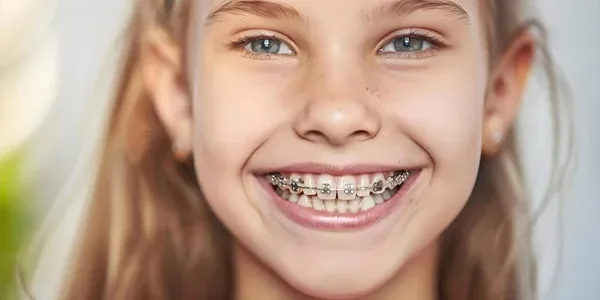Aesthetic Considerations for Braces vs. Invisalign
Dr. Hoss Abar
Choosing between braces and Invisalign isn’t just about correcting your smile—it’s also a decision that can impact how you feel about your appearance during treatment. For image-conscious individuals, aesthetics plays a significant role, especially regarding social interactions, self-confidence, and overall satisfaction with the orthodontic process. Traditional braces and Invisalign each offers unique visual experiences, from the subtlety of clear aligners to the noticeable presence of metal brackets. In this guide, we’ll explore the aesthetic differences between braces and Invisalign, discussing how each option can shape self-esteem and confidence for those who want a straighter smile without compromising appearance.
Visibility Matters: How Braces and Invisalign Differ Visually
When it comes to orthodontic treatment, visibility is sometimes a factor that determines the course of action. Braces and Invisalign also have a very different appearance, which means they present different levels of visibility in everyday life and how people see themselves.
Traditional Braces: Metal braces are very noticeable and include brackets and wires that are noticeable each time you smile or even talk. Although today’s braces are available in ceramic or clear materials so that they are not very conspicuous, they are still more conspicuous than aligners. Some people may find this visibility to be a barrier in social or professional life, especially for those who are self-conscious about how they look.

Invisalign: Invisalign aligners are made from a clear medical grade plastic that is intended to match the color of your teeth. This is a good treatment modality for people who seek to avoid cosmetic treatment options that can be easily detected in social activities. However, one of the biggest benefits of aligners is their invisibility; it is necessary to clean them and prevent them from staining.
The Self-Esteem Factor: Confidence with Braces and Invisalign
Braces: To some people, the appearance of conventional metal braces is unbecoming, especially to those who are in workplaces or other professional or social related places. Braces can be fixed, which might make people feel confined, and their visibility makes some people avoid taking photos or speaking in public. However, accepting braces can also lead to confidence since people are willing to change for the better and this is empowering.
Invisalign: The Invisalign aligners are less noticeable compared to the traditional braces, and this is a big plus for patients who are conscious about their appearance. The clear aligners are almost invisible, which makes people more comfortable during interactions since everyone’s focus is not on their teeth. This low-profile appearance can boost morale, especially for those who prefer not to overdo it. Also, the ability to take Invisalign out for a short while on occasion also gives people a level of control, which contributes to their comfort and confidence during the whole process.
Smile Transformations: Aesthetic Journey with Braces vs. Invisalign
With Braces: Braces are visible throughout treatment, meaning every adjustment shows gradual alignment changes that both the patient and others can see. This visibility allows people to track progress over time, noticing shifts in tooth alignment after each orthodontic visit. While braces are prominent, they make the transformation process transparent, and many find this rewarding, as it visually reinforces their commitment to achieving a straighter smile.
With Invisalign: Invisalign offers a more discreet journey, with changes that are less noticeable to others. Aligners are swapped out every one to two weeks, progressively shifting the teeth, and each new set feels like a step closer to the end result. Since aligners are removable, patients can compare their progress between wearing them, giving them control over how and when they view their own transformation. This more private journey can be empowering, particularly for those who prefer a low-profile approach to orthodontics.
Smile Milestones: Before and After Aesthetics with Braces and Invisalign
Invisalign Milestones
- Initial Aligners: The initial set of aligners is fitted, making it virtually impossible to tell that they are wearing them. Patients might feel relief and confidence in their treatment, knowing that no one will know what they are undergoing from the start.
- Every Two Weeks: While wearing their aligners, patients usually change them every one to two weeks, and minor changes to their smile are noticeable. Every new set introduces a minor shift in the design, so that patients can monitor their improvement on a daily basis.
- Midway Through Treatment (6-12 months): Halfway through the treatment, most patients can see the progress they have made. It is easier to see that the teeth are aligned better, and people gain a lot of confidence, which is important since the process is still discreet.
- Final Aligners: The final set of aligners brings the final changes, which give the patients a polished and straight set of teeth.
- After Removal: Treatment with Invisalign ends with aligners being taken off to expose a gorgeous set of aligned teeth. The patient can feel the change they have made without the need for braces to be noticeable.

Braces Milestones
- Initial Setup: The first day of the braces is the day when it all starts. Patients may be concerned about the new look they will have, but the joy of beginning treatment tops the fears that patients may have.
- First Adjustment (4-6 weeks): In the first month, patients experience a slight improvement in their tooth position. It is often slow but may be significant at this stage and can help to motivate the learner.
- Mid-Treatment (6-12 months): This is because by the six months’ mark, changes may begin to show, and the teeth start to move to the right positions. This period is also beneficial in that patients receive a chance to see their smile transformation in progress.
- Final Stages (12-24 months): Towards the end of the treatment, the change becomes very conspicuous and noticeable. Spaces disappear, teeth become more evenly positioned, and the patient tends to gain a lot of self-esteem.
- After Removal: The final goal is to have the braces off and to have the perfect set of teeth in front of the person. Patients are always happy and relieved, which is the climax of their experience.
Maintenance and Stain Prevention: Keeping Braces and Invisalign Looking Good
Braces: Regular metallic braces are more likely to trap some particles of food and, hence, are more likely to be stained, particularly at the brackets. Other products such as coffee, tea, and soda are also known to cause stains if they are not well controlled. Brush and floss are required daily, and the orthodontists may suggest the use of other accessories like interdental brushes to clean the food particles that may be trapped in the brackets. There are also other advantages that patients can get from not taking foods and drinks with a dark color, such as cleaner teeth and braces. Ceramic or tooth-colored braces are less noticeable but are even more susceptible to staining than metal braces, so caution is advised.
Invisalign: Invisalign aligners are clear and do not stain easily but they have to be clean and well maintained. Aligners must be removed while eating or drinking anything other than water because they are stain prone due to their nature of being removable. Aligners must be cleaned and brushed after meals to remove deposits and to keep them transparent, they can be soaked in an Invisalign cleaning solution. Staying away from colored drinks or tobacco also assists in keeping the aligners invisible and looking great during the treatment.
Through the above maintenance tips, both the braces and Invisalign user will maintain a clean and fresh orthodontic treatment hence having a positive attitude towards their smile during the course of the orthodontic treatment.
Contact your Pinole dentist, Dr. Hoss Abar, DDS, MSD at Abar Orthodontics, to learn more about aesthetic considerations for Braces vs. Invisalign.
Resource:
Five Types of Orthodontic Emergencies.
*This media/content or any other on this website does not prescribe, recommend, or prevent any treatment or procedure. Therefore, we highly suggest that you get the advice of a qualified dentist or other medical practitioners regarding your specific dental condition.*
More To Explore
About Us
We believe that every patient deserves to feel confident about their smile. Years of experience creating beautiful and flawless smiles.
Opening Hours:
Monday - Thursday: 8:00 AM - 5:00 PM
Friday: 8:00 AM - 12:00 PM
Saturday - Sunday: Closed
Abar Orthodontics, Pinole, CA
1500 Tara Hills Drive., Suite 204
Pinole, CA 94564
Abar Orthodontics, San Leandro, CA
145 East 14th street., #100
San Leandro, CA 94577
© 2025Abar Orthodontics | All rights reserved | Powered by:Vigorant, Inc.
